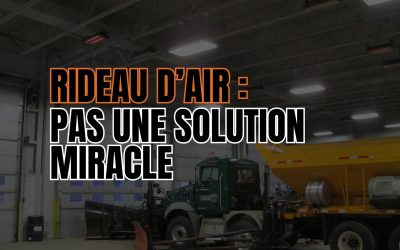Commercial, industrial and agricultural domes, whether temporary or permanent, pose specific heating challenges. Their considerable height, poor thermal insulation and large volume make traditional methods ineffective. Electric radiant heating, particularly infrared, is the ideal solution for these atypical spaces.
What is a dome?
A dome is a self-supporting or modular structure, often made of a flexible (fabric) or rigid membrane, suitable for a wide range of uses such as :
- Heavy equipment and machinery storage
- Bulk material storage
- Protection of mining sites
- Maintenance workshops
- Indoor riding arenas
- Agricultural or industrial warehouses
Infrared radiant heating: principle and operation
How does radiant heating work?
Unlike traditional systems, electric infrared radiant heating heats objects, surfaces and people directly, just like the sun. This heat is then distributed naturally throughout the space, creating an immediate and lasting sensation of comfort.
Technologies used
- Short-wave infrared heaters
- High installation height for optimum coverage
- Precise control via control panels with programmable thermostat
- Zone-specific heating to target only the most useful spaces
Advantages of radiant heating in domes
✅ Instant heat
No preheating required: as soon as you switch on, you feel the heat immediately.
✅ Maximum energy efficiency
Direct heating reduces heat loss, which is particularly high in poorly insulated structures.
✅ Draught resistance
Unlike convection heating, radiant heating is not affected by draughts, typical of modular or canvas buildings.
✅ Increased comfort for workers
The heat produced is even, pleasant and without noise or unpleasant air movement.
✅ Low maintenance
The absence of motors, filters or ducts significantly reduces maintenance requirements.
Comparison with other heating solutions
|
Type of heating |
Benefits |
Disadvantages |
|
Electric radiant (short-wave) |
– Highly efficient for large volumes |
– Requires power supply |
|
Radiant natural gas |
– Good efficiency |
– Ventilation required |
|
Forced-air system (convection heating) |
Simple installation |
– Inefficient in buildings with high ceilings |
Choisir le bon type de chauffage radiant pour un dôme
Pour les dômes, on privilégie généralement les appareils radiants à ondes infrarouge courtes, comme le modèle MTM avec lampes quartz, en raison de leur excellente efficacité énergétique et de leur chaleur instantanée. Permettant de chauffer directement les surfaces et non l’air ambiant. Il offre aussi une grande flexibilité d’usage, permettant de couvrir l’ensemble du dôme ou de chauffer uniquement une zone ciblée, par exemple pour le déglaçage d’un véhicule ou la fonte de matériaux en vrac. Cette capacité de chauffage par zone en fait une solution économique et parfaitement adaptée aux besoins variables des bâtiments de type dôme.
Concrete application examples
- De-icing stored materials (sand, gravel, minerals)
- Maintain a minimum temperature for heavy machinery and equipment
- Occasional heating of a vehicle to facilitate maintenance
- Creating heated zones in temporary or modular workshops
- Providing a comfortable environment for animals on agricultural rides
A concrete example: Mine dome heated by electric radiant heating
A mine storage dome was equipped with 10 infrared heaters strategically positioned on the ceiling. Using zone-targeted heating, the company found :
-
-
- A 40% reduction in energy costs compared with previous forced-air heating.
- Improved thermal comfort for employees working in the dome.
- Significant reduction in cold-related downtime, boosting overall productivity.
-

Conclusion
Pour les entreprises recherchant une solution efficace, économique et fiable pour chauffer leurs dômes commerciaux, industriels ou agricoles, le chauffage radiant électrique infrarouge se positionne clairement en tête des alternatives disponibles. Adapté aux spécificités des structures modulaires et souples, il offre un confort thermique incomparable, des économies d’énergie substantielles et un retour sur investissement rapide.
Choisir le chauffage radiant, c’est investir intelligemment dans un environnement productif et durable.
FAQ : Your questions, our answers
What type of heating is most effective for an industrial or agricultural dome?
Short-wave electric radiant heating (quartz lamp) is generally the most effective for domes, especially in environments with high ceilings, draughts or poor insulation. It provides targeted, rapid and energy-efficient heating.
Can a dome be partially heated (zone heating)?
Yes, one of the great advantages of radiant heating is its flexibility. It’s possible to heat only certain areas (e.g. work space, de-icing area), so you don’t have to waste energy heating the entire volume of the dome.
What maintenance is required for an electric radiant system?
Very little. Unlike gas systems, there are no burners or ventilation systems to maintain. All you need to do is periodically check that the reflectors are clean and the lamps in good condition.
Is a forced-air heater a good solution for a dome?
In most cases, no. Forced-air systems tend to heat the air, which rises rapidly in a dome, resulting in high losses and general inefficiency, especially in cold weather.
Does radiant heating work well in large spaces?
Absolutely. It’s ideal for buildings of all sizes, from single-family homes to warehouses.
Electric radiant heating is particularly effective in the following 4 scenarios.
- Space with strong draughts
- Space with high ceilings
- Zone heating
- Spot heating
How do I determine how many radiant heaters I need for my project?
It’s at this point that the Technirep team comes into play, preparing a customized proposal and design unique to each project.





0 Comments